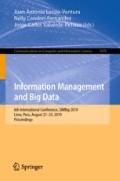Abstract
Towards the merchandising of a global brand, it is necessary to establish guidelines for marketing managers to define appropriate standardization/adaptation measures. Therefore, it is required to understand the construct of susceptibility to global consumer culture (SGCC) to position the brand according to the wishes and preferences of consumers belonging to specific segments of the global market. Based on three dimensions of the SGCI, proposed in literature: (i) social prestige; (ii) brand credibility; and (iii) social responsibility. This study aims to identify groups of global consumers; from different cultural backgrounds, ages, countries, among other characteristics; who share similar interests. For this purpose, an analysis and a comparison of four clustering algorithms are proposed. Besides, the best number of groups for each algorithm is calculated to find the groups that best explain the behavior of the global consumer. The results confirm the existence of a hybrid culture of global consumption, which produces companies to segment consumers from different countries based on similar or shared needs.
Access this chapter
Tax calculation will be finalised at checkout
Purchases are for personal use only
References
Neurolab. https://pypi.org/project/neurolab/. Accessed 05 July 2019
Akaka, M.A., Alden, D.L.: Global brand positioning and perceptions: international advertising and global consumer culture. Int. J. Advert. 29(1), 37–56 (2010)
Alden, D.L., Steenkamp, J.B.E., Batra, R.: Brand positioning through advertising in Asia, North America, and Europe: the role of global consumer culture. J. Mark. 63(1), 75–87 (1999)
Bezdek, J.C.: Pattern Recognition with Fuzzy Objective Function Algorithms. Springer, Heidelberg (2013)
Caliński, T., Harabasz, J.: A dendrite method for cluster analysis. Commun. Stat.-Theory Methods 3(1), 1–27 (1974)
Davies, D.L., Bouldin, D.W.: A cluster separation measure. IEEE Trans. Pattern Anal. Mach. Intell. 2, 224–227 (1979)
Dolnicar, S., Grün, B.: Methods in segmentation. In: Dietrich, T., Rundle-Thiele, S., Kubacki, K. (eds.) Segmentation in Social Marketing, pp. 93–107. Springer, Singapore (2017). https://doi.org/10.1007/978-981-10-1835-0_7
Du, K.L.: Clustering: a neural network approach. Neural Netw. 23(1), 89–107 (2010)
Dwivedi, A., Nayeem, T., Murshed, F.: Brand experience and consumers’ willingness-to-pay (WTP) a price premium: mediating role of brand credibility and perceived uniqueness. J. Retail. Consum. Serv. 44, 100–107 (2018)
Steenkamp, J.-B.E.M., Batra, R., Alden, D.L.: How perceived brand globalness creates brand value. J. Int. Bus. Stud. 34(1), 53–65 (2003). https://doi.org/10.1057/palgrave.jibs.8400002
Guzmán, F., Davis, D.: The impact of corporate social responsibility on brand equity: consumer responses to two types of fit. J. Prod. Brand Manag. 26(5), 435–446 (2017)
Hardy, A.: An examination of procedures for determining the number of clusters in a data set. In: Diday, E., Lechevallier, Y., Schader, M., Bertrand, P., Burtschy, B. (eds.) New Approaches in Classification and Data Analysis. STUDIES CLASS, pp. 178–185. Springer, Heidelberg (1994). https://doi.org/10.1007/978-3-642-51175-2_20
He, H., Zhu, W., Gouran, D., Kolo, O.: Moral identity centrality and cause-related marketing: the moderating effects of brand social responsibility image and emotional brand attachment. Eur. J. Mark. 50(1/2), 236–259 (2016)
Hernani-Merino, M., Mazzon, J.A., Isabella, G.: Modelo de suscetibilidade para a cultura de consumo global. Revista Brasileira de Gestao de Negocios 17, 1212–1227 (2015)
Höppner, F., Klawonn, F., Kruse, R., Runkler, T.: Fuzzy Cluster Analysis: Methods for Classification, Data Analysis and Image Recognition. Wiley, Hoboken (1999)
Huszagh, S.M.: Global marketing: an empirical investigation. Int. Executive 28(3), 7–9 (1986)
Makri, K., Papadas, K.K., Schlegelmilch, B.B.: Global-local consumer identities as drivers of global digital brand usage. Int. Mark. Rev. 36, 702–725 (2018)
Murray, P.W., Agard, B., Barajas, M.A.: Market segmentation through data mining: a method to extract behaviors from a noisy data set. Comput. Ind. Eng. 109, 233–252 (2017)
Ornek, O., Subasi, A.: Clustering marketing datasets with data mining techniques. In: The 2nd International Symposium on Sustainable Development, Sarajevo, Bosnia and Herzegovina, vol. 3, pp. 408–412 (2010)
Othman, M., Kamarohim, N., Nizam, F.M.: Brand credibility, perceived quality and perceived value: a study of customer satisfaction. Int. J. Econ. Manag. 11, 763–775 (2017)
Özsomer, A., Batra, R., Chattopadhyay, A., ter Hofstede, F.: A global brand management roadmap. Int. J. Res. Mark. 1(29), 1–4 (2012)
Pedregosa, F., et al.: Scikit-learn: machine learning in Python. J. Mach. Learn. Res. 12, 2825–2830 (2011)
Punj, G., Stewart, D.W.: Cluster analysis in marketing research: review and suggestions for application. J. Mark. Res. 20(2), 134–148 (1983)
Ross, T.J., et al.: Fuzzy Logic with Engineering Applications, vol. 2. Wiley Online Library, Hoboken (2004)
Xu, R., Wunsch, D.: Survey of clustering algorithms. IEEE Trans. Neural Netw. 16(3), 645–678 (2005)
Schwarz, G., et al.: Estimating the dimension of a model. Ann. Stat. 6(2), 461–464 (1978)
Shteyneker, A., Isaac, O., Al-Shibami, A.H.: Factors influencing consumer purchasing intention within fashion luxury brand in Malaysia Int. J. Manag. Hum. Sci. 3, 21–28 (2019)
Strizhakova, Y., Coulter, R.A., Price, L.L.: Branded products as a passport to global citizenship: perspectives from developed and developing countries. J. Int. Mark. 16(4), 57–85 (2008)
Taylor, C.R., Okazaki, S.: Do global brands use similar executional styles across cultures? A comparison of US and Japanese television advertising. J. Advert. 44(3), 276–288 (2015)
Vesanto, J., Alhoniemi, E.: Clustering of the self-organizing map. IEEE Trans. Neural Netw. 11(3), 586–600 (2000)
Wedel, M., Kamakura, W.: Market Segmentation: Conceptual and Methodological Foundations. Kluwer Academic Publishers, Berlin (1999)
Xu, D., Tian, Y.: A comprehensive survey of clustering algorithms. Ann. Data Sci. 2(2), 165–193 (2015)
Xu, R., Wunsch, D.: Clustering. Wiley-IEEE Press, Hoboken (2009)
Zhou, L., Teng, L., Poon, P.S.: Susceptibility to global consumer culture: a three-dimensional scale. Psychol. Mark. 25(4), 336–351 (2008)
Author information
Authors and Affiliations
Corresponding author
Editor information
Editors and Affiliations
Rights and permissions
Copyright information
© 2020 Springer Nature Switzerland AG
About this paper
Cite this paper
Medina-Rodríguez, R., Talavera, A., Hernani-Merino, M., Lazo-Lazo, J., Mazzon, J.A. (2020). Global Brand Perception Based on Social Prestige, Credibility and Social Responsibility: A Clustering Approach. In: Lossio-Ventura, J.A., Condori-Fernandez, N., Valverde-Rebaza, J.C. (eds) Information Management and Big Data. SIMBig 2019. Communications in Computer and Information Science, vol 1070. Springer, Cham. https://doi.org/10.1007/978-3-030-46140-9_25
Download citation
DOI: https://doi.org/10.1007/978-3-030-46140-9_25
Published:
Publisher Name: Springer, Cham
Print ISBN: 978-3-030-46139-3
Online ISBN: 978-3-030-46140-9
eBook Packages: Computer ScienceComputer Science (R0)

